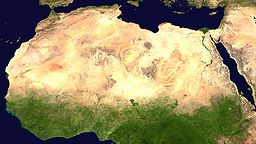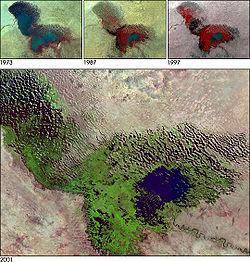by Conor Godfrey on March 4, 2011
Big projects capture the imagination. They attempt to solve big problems with eye-popping solutions. The Apollo missions, the Panama Canal, the Hoover Damn; these were projects that defined generations.
How about this for a big project– a wall of trees, 15 kilometers thick, stretching 8,000 km from Dakar to Djibouti, interlaced with water retention ponds and plants designed to improve soil quality.
This is exactly the big idea that got its final approval this week in Bonn, at the UN Convention to Combat Desertification.
Just as competition with the U.S.S.R. spurred the U.S. into high gear in the space race, the Great Green Wall project also has a nemesis—the Sahara Desert.
This sandy foe creeps south at approx 48 kilometers per year consuming farm and pasture land in a decades long war of attrition.
In some cases, such as Nigeria, the desert claims almost 1,400 square miles of land every year.
Many months ago on this blog I wrote about this very problem; desertification and other forms of environmental degradation have put Nigeria’s identity groups on a collision course, competing for ever scarcer environmental resources.
Take a look at this picture of Lake Chad.
The blue represents the actual lake, and the green demarcates the lake’s historical limits.
Lake Chad has shrunk by 95% in the last 50 years.
The consensus view among experts is that about 50% of the water loss was caused by desertification due to overgrazing, and the other 50% to long term climatic changes.
Chad is a major supporter of the Great Green Wall project.
11 desert and Sahel countries–Burkina Faso, Chad, Djibouti, Eritrea, Ethiopia, Mali, Mauritania, Niger, Nigeria, Senegal and Sudan—will collaborate to implement the massive Great Green Wall.
This will require unprecedented collaboration between 11 countries, with 11 environmental/agriculture ministries, teams of international scientists, and thousands of communities in the Sahel speaking a multitude of local languages.
I am skeptical but inspired.
Much like other big projects launched to solve big problems, the three gorges Dam or the Panama Canal for example; the devil will be in the details.
In addition to standard worries about corrupt contractors, the real worry here is simple free riding. Each country faces a threat from desertification, but the threat level varies, and the implementing capacity of each country varies even more.
The funding will mostly come from outside sources, including $119 million from the Global Environment Facility (GEF), and several billion dollars from other international donors, but each participating country will be responsible for educating local communities and managing modern tree nurseries, as well as the logistics involved in continuously transporting saplings and other inputs to the Green Wall.
The projects supporters claim that the wall will “sequester 3.1. million tons of carbon”, reverse Sahel desertification, improve the climate in the semi-arid Sahel region, and offer income generating activities for communities that border the wall.
Detractors question this narrative: they note that the Sahara is not advancing per se, but rather over grazing and deforestation in the border regions have removed the roots that traditionally anchored the soil, leaving the soil vulnerable to wind and other elements.
And how will local communities benefit in the short term?
Even if an education campaign succeeded in connecting changing climate patterns and decreasing pastureland with the absence of trees, how local communities justify taking time from tending their own land, animals, or jobs to manage their section of the wall when the benefits will not be apparent for years?
I would be very interested to hear opinions on this project from conservationist or from people that have lived in Sahel communities.
Note: This has been tried before. In China most recently, and in U.S. back in the 1930s on a much smaller scale in the “Shelterbelt Project”.